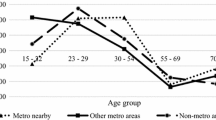Abstract
U.S. interstate migrants (over a five-year period) are separated into three groups: (a) those leaving state of birth; (b) those returning to state of birth; and (c) those outside state of birth at the beginning of the period and moving on to a third state by the end. Evidence is presented suggesting that the third group is particularly selective of persons with high social and economic status. The findings are linked to certain hypotheses about the changing role and function of migration in a highly developed country where the transition from a rural society based on agriculture has essentially been completed.
Similar content being viewed by others
References
Eldridge, Hope T., and D. S. Thomas. 1964. Demographic Analyses-and Interrelations. Vol. 3 of Population Redistribution and Economic Growth, United States, 1870–1950. Philadelphia: The American Philosophical Society.
— 1965. Primary, Secondary and Return Migration in the United States, 1955–60. Demography 2:445–455.
Goldstein, S. 1964. The Extent of Repeated Migration: An Analysis Based on the Danish Population Register. Journal of the American Statistical Association 59:1121–1132.
Kuznets, S. S. 1964. Introduction. Pp. xxiii-xxxv in Hope T. Eldridge and D. S. Thomas, Demographic Analyses and Interrelations. Vol. 3 of Population Redistribution and Economic Growth, United States, 1870–1950. Philadelphia: American Philosophical Society.
Lee, A. S. 1974. Return Migration in the United States. International Migration Review 8:283–300.
Lee, E. S. 1966. A Theory of Migration. Demography 3:47–58.
Long, John F. 1976. Determinants of the Interstate Migration of the Civilian, Non-College Population. Paper presented at the annual meeting of the Population Association of America, Montreal, April 29–May 1, 1976.
Long, L. H. 1974. Women’s Labor Force Participation and the Residential Mobility of Families. Social Forces 52:342–348.
Miller, Ann R. 1965. Migration Differentials Among Occupation Groups: United States, 1960. Paper presented to the World Population Conference (A.3/V/E/179).
— 1966. Migration Differentials in Labor Force Participation: United States, 1960. Demography 3:58–67.
— 1974. The Black Migrant: Changing Origins, Changing Characteristics. Atlanta: W. E. B. DuBois Institute for the Study of the American Black.
Morrison, Peter A. 1970. Chronic Movers and the Future Redistribution of Population: A Longitudinal Analysis. Santa Monica, Calif.: The Rand Corporation.
Newton, Mary P., and J. R. Jeffery. 1951. Internal Migration: Some Aspects of Population Movements Within England and Wales. London: Her Majesty’s Stationery Office.
Ravenstein, E. G. 1889. The Laws of Migration. Journal of the Royal Statistical Society 52:241–301.
Robinson, J. Gregory. 1975. Demographic Evidence of the Misreporting of State of Birth and Nativity in the 1970 Census. Unpublished paper. Philadelphia: Population Studies Center, University of Pennsylvania.
Rowntree, John A. 1957. Internal Migration: A Study of the Frequency of Movement of Migrants. London: Her Majesty’s Stationery Office.
Saben, S. 1964. Geographic Mobility and Employment Status, March 1962–March 1963. Monthly Labor Review 87:873–881.
Shryock, Henry S. 1964. Population Mobility Within the United States. Chicago: Community and Family Study Center, University of Chicago.
— and C. P. Nam. 1965. Educational Selectivity of Interregional Migration. Social Forces 43:299–310.
Taeuber, Karl E., L. Chiazze, and W. Haenszel. 1968. Migration in the United States, an Analysis of Residence Histories. Washington, D.C.: Public Health Monograph No. 77, U.S. Government Printing Office.
U.S. Bureau of the Census. 1963. U.S. Census of Population: 1960. Subject Reports. Lifetime and Recent Migration. Final Report PC(2)-2D. Washington, D.C.: U.S. Government Printing Office.
—. 1973a. Census of Population: 1970. Subject Reports. Final Report PC(2)-2D. Lifetime and Recent Migration. Washington, D.C.: U.S. Government Printing Office.
—. 1973b. Census of Population: 1970. Subject Reports. Final Report PC(2)-2B. Mobility for States and the Nation. Washington, D.C.: U.S. Government Printing Office.
Author information
Authors and Affiliations
Rights and permissions
About this article
Cite this article
Miller, A.R. Interstate migrants in the United States: Some social-economic differences by type of move. Demography 14, 1–17 (1977). https://doi.org/10.2307/2060451
Issue Date:
DOI: https://doi.org/10.2307/2060451




